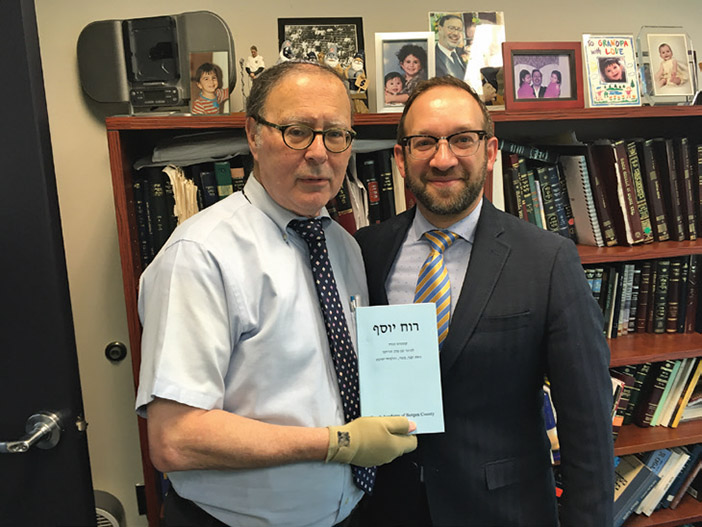
This Shavuot, TABC will release its first-ever sefer, containing 20 original Torah and Gemara articles in Hebrew and English written by TABC rabbanim, students and alumni. Copies of the sefer will be available at most Teaneck, Bergenfield, Fair Lawn and Englewood shuls on Shavuot as part of TABC’s community-wide learning program, and TABC is open to printing more copies if there is interest.
The title of the sefer, “Ruach Yosef,” alludes to the contributions made to TABC by two men who share the name Yosef: Rav Yosef Dov Soloveitchik, zt”l, on the occasion of his 25th yahrtzeit, and TABC Rosh Yeshiva Rabbi Yosef Adler. The sefer’s dedication enumerates three ways the Rav shaped the ideological foundations of TABC: “First and foremost, the Rav’s commitment to intensive, rigorous and creative limud HaTorah remains the foundation stone of our yeshiva. Second, the Rav’s embrace of the wisdom of all disciplines of human knowledge, from mathematics and sciences to literature and history, not merely as a means through which to secure gainful employment, but as critical facets that deepen and enrich one’s avodat Hashem, animates our approach to general studies. Finally, the Rav’s characterization of the founding of Medinat Yisrael as nothing short of the sound of our Beloved knocking, kol Dodi dofeik, remains the conceptual and ideological framework through which we strive to educate toward the centrality and spiritual significance of Medinat Yisrael.”
Rabbi Daniel Fridman, TABC’s sgan rosh yeshiva, who spearheaded and organized the sefer, credited Rabbi Adler, TABC’s rosh yeshiva, for implanting the Rav’s teachings and legacy into the ethos of TABC. “Any talmid who walks through the halls of this yeshiva understands that the ruach of Yosef continues to animate the yeshiva through Rabbi Adler,” Rabbi Fridman told The Jewish Link.
The sefer contains two sections, with the first part focusing on Sefer Devarim of Torah Shebichtav, and the second part focusing on Masechet Kiddushin of Torah Sheba’al Peh. Rabbi Fridman asserted that this breakdown reflects TABC’s educational philosophy. “Historically,” Rabbi Fridman said, “yeshivot have not paid a sufficient amount of attention to Torah Shebichtav. In Israel, the situation is considerably different in the last number of generations, but yeshivot in chutz la’aretz continue to, by and large, lag behind in that respect. So there’s an innovative aspect to the sefer, which is that under the leadership of many decades of Rabbi Adler, Torah Shebichtav was very much part of the program here, and I feel very strongly that that approach is the optimal approach.”
The sefer was created because of “both objective and contextual reasons,” said Rabbi Fridman. “[Given] that we’re learning and ‘Ee efshar l’beit midrash b’lo chidush’ (‘there can be no house of study without innovation’—Gemara Chagiga 3a), we’d better produce chidushim (novel approaches to Torah). And if we’re producing chidushim, we should share those with the community.” Rabbi Fridman believes that as an institution of Torah learning it is incumbent upon TABC to share its brightest insights with the broader Jewish community.
The contextual need for the sefer was important, as was the timing of its release, said Rabbi Fridman: “It’s very important, especially in the context of our Shavuot learning program, that our yeshiva be associated in the community with learning at the highest level. And by the highest level I mean something very specific: rigor and creativity. Part of the rigor is reflected in taking the ideas and not just allowing them to float off into the stratosphere—recording them and writing them down and capturing them. And creativity [is reflected] in terms of chidushei Torah.”
Aside from providing the community with Torah messages, Rabbi Fridman sees the sefer as a source of both pride and inspiration for the community. “I hope that the community at large will take a great source of pride from having a community school that is capable of producing such Torah,” he said. “Even those who may not read every article in the sefer surely can be aware that both rigorous and creative talmud Torah is being produced, and it’s a point of pride.”
In terms of inspiration, Rabbi Fridman explained, “Especially for those families with younger children who value this sort of Torah, to be able to point at something concrete and say, ‘Maybe my son is in third grade now, but by the time he’s in ninth, 10th, 11th, 12th grade, he could be doing this’—it creates a sense of aspiration as well as a sense of inspiration.”
The goal is for this sefer to be the first volume of an annual TABC Torah publication, not just a one-time milestone. “I would be crestfallen if this was a one-time thing,” said Rabbi Fridman. “‘Maalin bakodesh v’lo moridin’ (‘we rise in holiness and do not fall’). It’s very important for our yeshiva to do this on an annual basis … This will be krach aleph (Volume 1), but we very much want that this should continue for as long as the yeshiva continues.”
This Shavuot, keep an eye out for a pale blue sefer at your local shul. Im yirtzeh Hashem, it will be the first installment of a long, illustrious line of sefarim to come.
By Tani Greengart
Tani Greengart is a senior at TABC and a current intern at The Jewish Link. He wrote two articles for TABC’s new sefer, Ruach Yosef.










